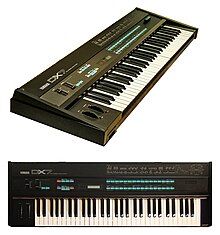
Back Yamaha DX7 Catalan Yamaha DX7 Danish Yamaha DX7 German Yamaha DX7 Spanish یاماها دیایکس۷ Persian Yamaha DX7 Finnish Yamaha DX7 French Yamaha DX7 Italian ヤマハ・DXシリーズ Japanese Yamaha DX7 Dutch
| Yamaha DX7 | |
|---|---|
 | |
| Manufacturer | Yamaha |
| Dates | May 1983–1989 |
| Price | $1,995 US £1,495 GBP ¥248,000 JPY |
| Technical specifications | |
| Polyphony | 16-voice |
| Timbrality | Monotimbral Bi-timbral (DX7 II) |
| Oscillator | 6 digital sine wave operators per voice, 32 patching algorithms[1] |
| Synthesis type | Digital linear frequency modulation / Additive synthesis (alg. #32) |
| Filter | none |
| Attenuator | 1 pitch envelope & 6 amplitude generators per voice |
| Aftertouch expression | Yes (channel) |
| Velocity expression | Yes |
| Storage memory | 32 patches in RAM (battery backup); front panel ROM/RAM cartridge port |
| Effects | none |
| Hardware | YM2128 (OPS) operator chip YM2129 (EGS) envelope generator |
| Input/output | |
| Keyboard | 61-note with velocity and aftertouch sensitivity |
| Left-hand control | pitch-bend and modulation wheels |
| External control | MIDI in/out/thru, input for foot controller x2, input for foot switch x2, input for optional breath controller |
The Yamaha DX7 is a synthesizer manufactured by Yamaha Corporation from 1983 to 1989. It was the first successful digital synthesizer and is one of the best-selling synthesizers in history, selling more than 200,000 units.
In the early 1980s, the synthesizer market was dominated by analog synthesizers. FM synthesis, a means of generating sounds via frequency modulation, was developed by John Chowning at Stanford University, California. FM synthesis created brighter, glassier sounds, and could better imitate acoustic sounds such as brass and bells. Yamaha licensed the technology to create the DX7, combining it with very-large-scale integration chips to lower manufacturing costs.
With its complex menus and lack of conventional controls, few learned to program the DX7 in depth. However, its preset sounds became staples of 1980s pop music; in 1986, it was used in 40% of the number-one singles on the US Billboard Hot 100. Its electric piano sound was particularly widely used, especially in power ballads. The English producer Brian Eno was proficient at programming his own sounds, and it was instrumental to his work in ambient music. Chips based on the DX7 sound chip, such as the YM2612, were used in technologies such as the Sega Genesis game console.
The DX7 was succeeded by FM synthesizers including the DX1, DX21, DX27 and DX100. In later years, the DX7 sounds came to be seen as dated or clichéd and its use declined.
- ^
"Chapter 2: FM Tone Generators and the Dawn of Home Music Production". History, Yamaha Synth 40th Anniversary. Yamaha Corporation. 2014. Archived from the original on October 23, 2014.
At that time, a number of Yamaha departments were developing different instruments in parallel, ... the direct forerunner of the DX Series synths was a test model known as the Programmable Algorithm Music Synthesizer (PAMS). In recognition of this fact, the DX7 is identified as a Digital Programmable Algorithm Synthesizer on its top panel. / As its name suggests, the PAMS created sound based on various calculation algorithms—namely, phase modulation, amplitude modulation, additive synthesis, and frequency modulation (FM)—and from the very start, the prototype supported the storing of programs in memory. However, this high level of freedom in sound design came at the price of a huge increase in the number of parameters required, meaning that the PAMS was not yet suitable for commercialization as an instrument that the average user could program. / In order to resolve this issue, the Yamaha developers decided to simplify the synth's tone generator design by having the modulator and carrier envelope generators share common parameters. They also reduced the number of algorithms—or operator combination patterns—to 32.